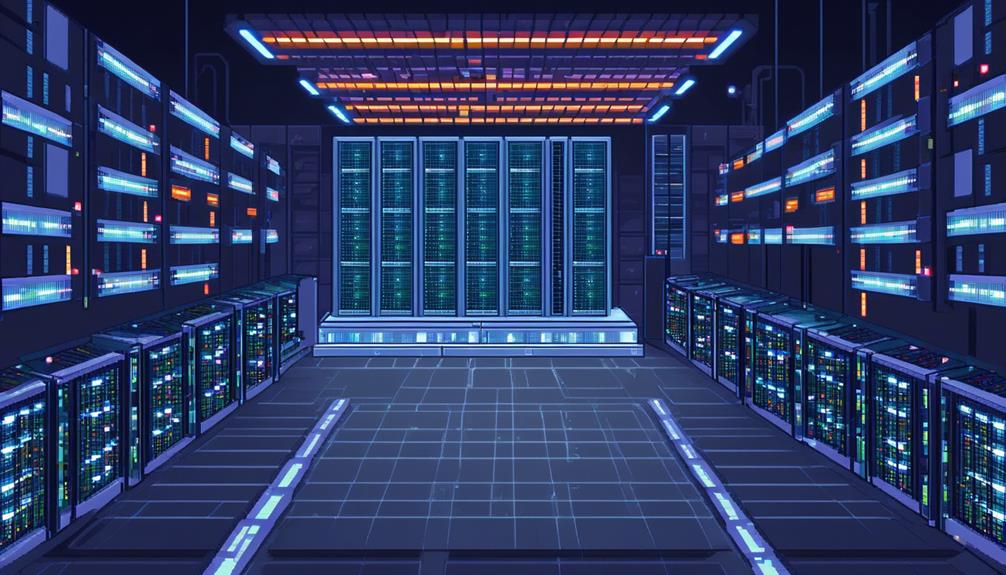In the realm of data centers, energy efficiency has emerged as a critical concern. As organizations increasingly rely on these facilities to store and process massive amounts of data, the demand for power consumption continues to rise. However, this surge in energy usage comes at a cost to both the environment and the bottom line.
To mitigate these challenges, data centers must adopt strategies and technologies that optimize energy efficiency. This discussion will explore the various approaches, from effective cooling strategies and hardware optimization techniques to virtualization and consolidation, that can help data centers minimize energy waste and maximize performance.
By implementing these measures, data center operators can not only reduce their environmental impact but also achieve substantial financial savings and support the ongoing modernization of their infrastructure.
Key Takeaways
- Energy efficiency in data centers is crucial for reducing carbon footprint and lowering operational costs.
- Effective cooling strategies, such as airflow management techniques and liquid cooling solutions, can optimize cooling system performance.
- Server optimization maximizes resource utilization, reduces the number of physical servers, and lowers power consumption and operational costs.
- Integrating renewable energy sources into data centers reduces reliance on traditional energy sources, promotes sustainable practices, and contributes to global efforts in combating climate change.
Importance of Energy Efficiency
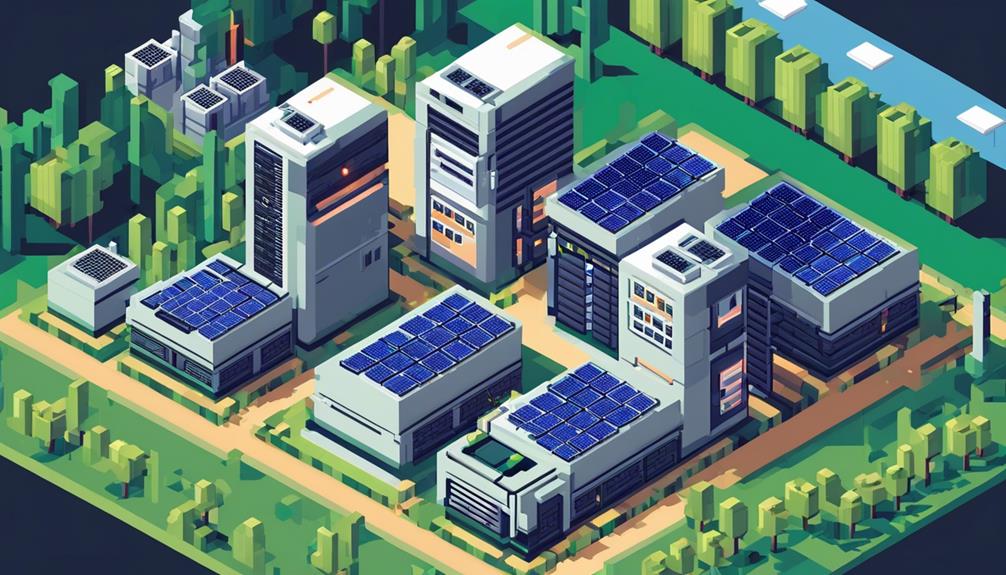
The importance of energy efficiency in data centers cannot be overstated, as it plays a crucial role in reducing carbon footprint and lowering operational costs. Energy-efficient data centers are designed to optimize the use of energy resources, resulting in significant efficiency gains. By implementing sustainable computing practices, organizations can reduce their environmental impact while also benefiting financially.
Reducing operational costs is one of the primary drivers for adopting energy-efficient data centers. The energy consumed by data centers can account for a significant portion of an organization's operational expenses. By implementing energy-efficient measures, such as using more efficient hardware, implementing virtualization, and optimizing cooling systems, organizations can achieve substantial cost savings. These efficiency gains not only reduce the energy consumption but also lead to a decrease in operational expenses, allowing organizations to allocate resources to other critical aspects of their business.
Moreover, prioritizing energy efficiency in data centers can position organizations as leaders in sustainable computing. In today's world, where environmental responsibility is becoming increasingly important, organizations that demonstrate a commitment to sustainability are more likely to attract and retain top talent. Sustainable computing practices not only help future-proof organizations against the growing demands for environmental responsibility but also build stronger relationships with customers and stakeholders.
Commitment to energy efficiency also contributes to a more sustainable future for the planet. By reducing carbon footprint, organizations can help meet their environmental, social, and governance (ESG) goals. Sustainable computing practices align with the growing customer and stakeholder demand for sustainability, enhancing the organization's reputation as a responsible and forward-thinking leader.
Effective Cooling Strategies
To ensure efficient cooling in data centers, implementing airflow management techniques is crucial. This involves optimizing the layout of equipment and using containment systems like hot aisle/cold aisle design to direct airflow effectively.
Additionally, considering liquid cooling solutions, such as direct liquid cooling (DLC) technologies, can further enhance energy efficiency by reducing the overall power consumption of cooling systems.
Airflow Management Techniques
Can airflow management techniques enhance cooling efficiency in data centers? Yes, implementing effective airflow management techniques is crucial for optimizing cooling system performance and improving data center energy efficiency. By utilizing strategies such as the hot aisle/cold aisle layout, containment enclosures, raised floor tiles, blanking panels, and grommets, data centers can ensure proper airflow distribution, minimize air leakage, and enhance cooling effectiveness. These techniques help to create a controlled airflow environment, eliminating hotspots and reducing the workload on cooling systems. By optimizing airflow, data centers can achieve more efficient cooling, reducing energy consumption and operating costs. The table below provides an overview of these airflow management techniques and their benefits:
| Airflow Management Technique | Benefits |
|---|---|
| Hot Aisle/Cold Aisle Layout | Optimizes airflow for cooling efficiency |
| Containment/Enclosures | Manages airflow and enhances cooling effectiveness |
| Perforated Raised Floor Tiles | Improves airflow distribution |
| Blanking Panels and Grommets | Prevents air leakage and optimizes cooling |
Liquid Cooling Solutions
Implementing liquid cooling solutions is a highly effective strategy for enhancing cooling efficiency in data centers. It builds upon the previously discussed airflow management techniques. Liquid cooling is a more efficient method for cooling data center hardware compared to traditional air-based cooling. By utilizing liquid cooling units, CPUs can run cooler, reducing the energy required for cooling and potentially leading to energy savings.
Additionally, liquid cooling solutions can help reduce noise levels in the data center environment, creating a more comfortable working environment. This cooling method is particularly beneficial for high-performance hardware that generates higher levels of heat.
When implemented effectively, liquid cooling solutions contribute to overall energy efficiency in data center operations. They improve the sustainability and cost-effectiveness of these facilities.
Hot Aisle/Cold Aisle Design
The Hot Aisle/Cold Aisle Design is a layout that effectively separates hot and cold air aisles in data centers, optimizing cooling efficiency and reducing energy consumption. By implementing this design, data centers can reduce power consumption and improve energy efficiency.
In this layout, racks are arranged in alternating rows, with the front of the servers facing the cold aisle and the back facing the hot aisle. This separation prevents the mixing of hot and cold air, allowing for more efficient cooling. By directing cold air to the front of the servers and hot air to the back, the cooling system can operate more effectively, resulting in lower energy usage.
Implementing the Hot Aisle/Cold Aisle Design is a practical and cost-effective strategy to improve energy efficiency in data centers.
Hardware Optimization Techniques
Optimizing hardware is crucial to achieving energy efficiency in data centers. By implementing hardware optimization techniques, data centers can significantly reduce power usage and improve overall energy efficiency. Here are three key strategies for hardware optimization:
- Utilize built-in server power management features: Modern servers often come with power management features that allow for fine-grained control over power usage. By configuring these features to match the workload demands, data centers can optimize energy consumption. For example, servers can be set to throttle down or enter sleep mode during periods of low utilization, reducing power consumption without affecting performance.
- Upgrade to energy-efficient IT equipment: Older hardware tends to be less energy-efficient compared to newer models. By upgrading to energy-efficient IT equipment, data centers can take advantage of advancements in technology that result in lower power consumption. This includes servers, networking equipment, storage devices, and cooling systems. Investing in energy-efficient hardware may require upfront costs but can lead to significant long-term energy savings.
- Consolidate lightly-used servers: Many data centers have servers that are lightly utilized or idle for a significant portion of the time. By consolidating these servers onto fewer physical machines through techniques like virtualization, data centers can achieve higher resource utilization and reduce power consumption. Virtualization technology enables multiple virtual machines to run on a single physical server, optimizing hardware utilization and reducing the number of idle or underutilized servers.
Virtualization and Consolidation
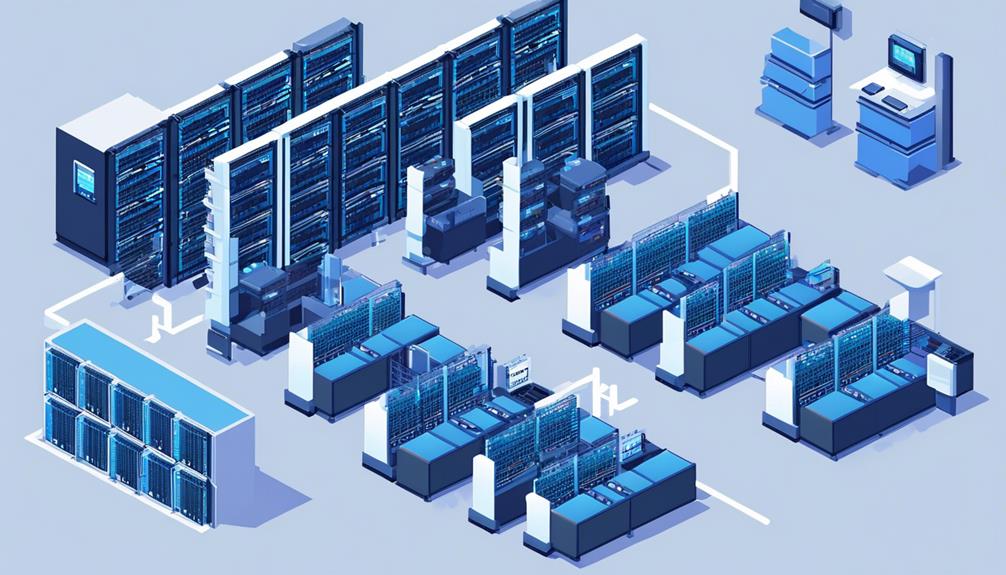
Virtualization and consolidation play a crucial role in improving the energy efficiency of data centers.
Server optimization involves maximizing the utilization of resources by combining lightly-used servers, reducing the overall power consumption.
Resource pooling enables the sharing of resources among multiple virtual machines, further optimizing energy use.
Workload consolidation allows for the efficient allocation of workloads to minimize energy waste.
Server Optimization
Server optimization is a critical strategy in data center energy efficiency. This strategy encompasses techniques such as virtualization and consolidation to enhance server performance and reduce energy consumption.
By implementing server virtualization and consolidation, organizations can reduce the number of physical servers and optimize their usage. This reduction in physical servers leads to a significant reduction in data center space and power consumption.
Utilizing virtualization technology allows for improved server efficiency and the consolidation of workloads onto fewer physical machines. This not only maximizes resource utilization but also reduces operational costs associated with power management.
Resource Pooling
As organizations seek to enhance server performance and reduce energy consumption in data centers, a critical strategy to consider is resource pooling, specifically through virtualization and consolidation techniques. Resource pooling involves consolidating lightly-used servers to maximize resource utilization, optimizing virtualization technology to enable efficient resource allocation and utilization. Additionally, efficient data storage measures are implemented as part of resource pooling to optimize storage resources. Utilizing built-in server power management features is also a key aspect of resource pooling to minimize energy consumption. Furthermore, upgrading to energy-efficient IT equipment is an essential component of resource pooling, enhancing overall efficiency in data centers and reducing overall energy usage. The table below summarizes the key aspects and benefits of resource pooling in data centers:
| Aspects of Resource Pooling | Benefits |
|---|---|
| Consolidation of servers | Maximizes resource utilization |
| Optimization of virtualization technology | Efficient resource allocation and utilization |
| Efficient data storage measures | Optimizes storage resources |
| Utilization of server power management features | Minimizes energy consumption |
| Upgrading to energy-efficient IT equipment | Enhances overall efficiency in data centers |
Workload Consolidation
Workload consolidation, a critical strategy for optimizing resource utilization and reducing energy consumption in data centers, involves the consolidation of lightly-used servers. By implementing efficient data storage measures and optimizing virtualization technology, data centers can achieve significant energy efficiency gains.
Here are three key aspects of workload consolidation for energy efficiency:
- Utilizing built-in server power management features: Data centers can take advantage of power management features in servers to dynamically adjust power consumption based on workload demands. By optimizing power usage, energy efficiency is improved.
- Upgrading to energy-efficient IT equipment: Replacing outdated and inefficient IT equipment with energy-efficient alternatives can greatly reduce energy consumption in data centers. Modern servers and storage devices are designed to operate more efficiently, leading to energy savings.
- Virtualization technology: Workload consolidation involves reducing the number of physical servers through virtualization. This enables the efficient allocation of computing resources, reducing energy usage and maximizing resource utilization in data centers.
Power Management Solutions
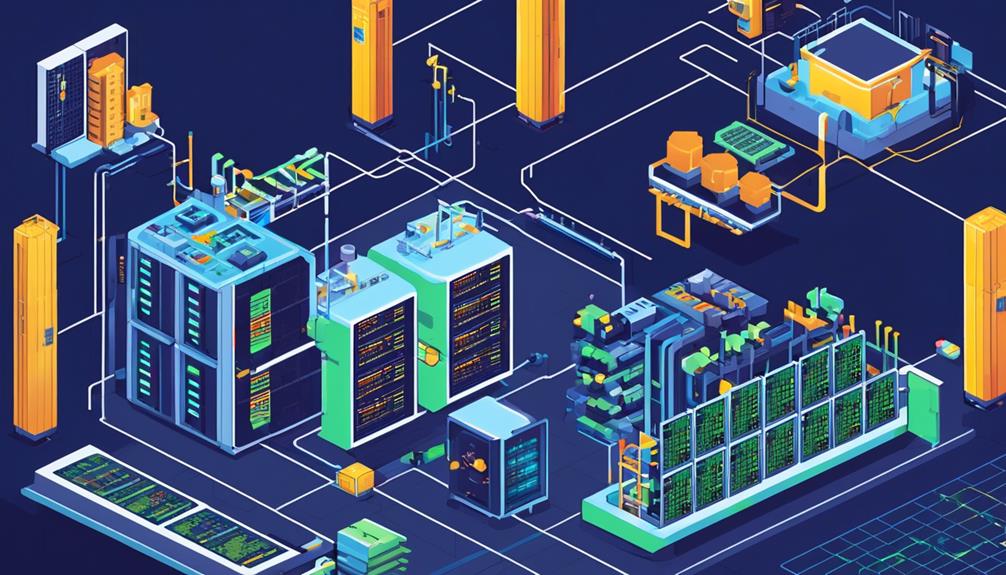
Power management solutions play a pivotal role in optimizing energy usage and enhancing efficiency in data centers. These solutions enable data center operators to effectively manage and control power consumption, leading to significant reductions in data center energy costs. By implementing power management solutions, organizations can take advantage of various strategies and technologies to improve energy efficiency.
One of the key benefits of power management solutions is the ability to consolidate lightly-used servers. By identifying and consolidating workloads onto fewer servers, data centers can reduce power consumption by maximizing the utilization of existing resources. This not only saves energy but also reduces operational costs associated with cooling and maintenance.
Power management solutions also facilitate the use of efficient data storage measures. By implementing technologies such as data deduplication and compression, data centers can reduce the amount of physical storage required, resulting in lower power consumption. Additionally, these solutions enable organizations to utilize built-in server power management features effectively, such as turning off or putting servers into a low-power state during periods of low demand.
Furthermore, power management solutions support the upgrade to energy-efficient IT equipment. By providing visibility into power consumption and performance metrics, these solutions assist in identifying and replacing inefficient equipment with more energy-efficient alternatives. This not only reduces energy usage but also improves overall data center performance.
Lastly, power management solutions can optimize virtualization technology for better energy efficiency in data centers. By intelligently managing virtual machine placement and workload balancing, these solutions ensure that resources are utilized efficiently, reducing power consumption and maximizing the use of virtualization capabilities.
Overall, power management solutions play a crucial role in improving energy efficiency and reducing data center energy costs. The implementation of these solutions enables organizations to optimize energy usage, consolidate resources, and upgrade to more energy-efficient equipment, resulting in significant cost savings and environmental benefits.
| Benefits of Power Management Solutions |
|---|
| Consolidation of lightly-used servers |
| Efficient data storage measures |
| Effective utilization of built-in server power management features |
| Upgrade to energy-efficient IT equipment |
| Optimization of virtualization technology |
Renewable Energy Integration
Integrating renewable energy sources, such as solar, wind, and hydroelectric power, into data center operations is a crucial step towards reducing reliance on traditional energy sources and promoting sustainable energy practices. Data centers consume significant amounts of electricity, and their energy demands are expected to grow exponentially in the coming years.
By harnessing renewable energy, data centers can reduce their carbon footprint and contribute to global efforts in combating climate change. Here are three key aspects of renewable energy integration in data centers:
- Investing in renewable energy infrastructure: To generate clean energy for powering data center operations, investments need to be made in renewable energy infrastructure. This includes installing solar panels, wind turbines, and hydroelectric systems. These technologies can harness the power of nature to generate electricity without emitting greenhouse gases.
- Collaborating with renewable energy providers: Data centers can collaborate with renewable energy providers to ensure a consistent and reliable supply of renewable energy. This can be achieved through power purchase agreements (PPAs) or by establishing on-site renewable energy generation facilities. By partnering with renewable energy providers, data centers can access a sustainable energy source and support the growth of the renewable energy sector.
- Implementing energy procurement strategies: Data centers can adopt energy procurement strategies to optimize their use of renewable energy. This can involve a combination of on-site generation, purchasing renewable energy credits (RECs), and participating in demand response programs. By strategically procuring renewable energy, data centers can maximize their energy efficiency and minimize their environmental impact.
Efficient Data Center Design
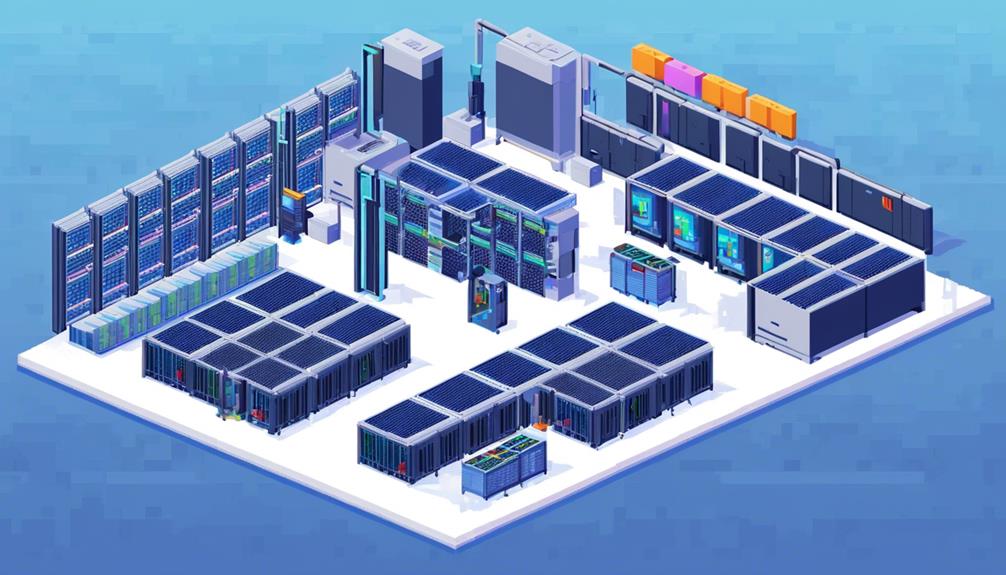
Efficient data center design involves implementing cooling systems and power management strategies.
Cooling systems, such as utilizing hot aisle/cold aisle layouts and installing containment/enclosures, can optimize cooling efficiency.
Power management measures, such as consolidating lightly-used servers and utilizing built-in server power management features, can optimize IT equipment energy usage.
These design strategies contribute to overall energy efficiency in data centers.
Cooling Systems
One approach to enhancing the efficiency of data center cooling systems involves the utilization of variable-speed fans, liquid cooling, temperature adjustments, drive selection, and cloud-based services.
Switching to variable-speed fans can decrease power consumption by 20% through CPU fan speed reduction.
Liquid cooling is more effective than air-based methods and can reduce the energy required for cooling.
Raising the temperature can result in an immediate drop in power usage from the cooling system without additional investment.
Using bigger, slower drives can reduce energy consumption and heat production.
Utilizing cloud-based services can externalize power consumption and increase energy efficiency.
Power Management
To enhance the overall efficiency of data centers, the implementation of power management strategies is crucial in achieving efficient data center design. Power management plays a vital role in optimizing energy efficiency and reducing operational costs.
One approach is to utilize built-in server power management features, such as power capping and power states, to regulate power consumption based on workload demands.
Another effective strategy is to optimize virtualization technology, which enables the consolidation of multiple servers onto a single physical server, thereby reducing power requirements.
Implementing power monitoring and management systems allows for real-time monitoring and control of power usage, ensuring efficient utilization of resources.
Upgrading to energy-efficient IT equipment, such as servers, storage devices, and networking equipment, further enhances power management in data centers.
Additionally, implementing energy-efficient lighting systems helps minimize power consumption.
Monitoring and Reporting Tools
Monitoring and reporting tools play a crucial role in providing real-time visibility into energy consumption and performance metrics of data center equipment. These tools enable data center operators to effectively monitor and manage energy usage, contributing to enhanced energy efficiency.
Here are three key functions of monitoring and reporting tools in data centers:
- Identifying and Analyzing Energy Usage Patterns: Monitoring tools collect data on energy consumption and performance metrics of data center equipment. This data can be analyzed to identify patterns and trends in energy usage, helping operators to pinpoint areas of inefficiency. By understanding where energy is being wasted or underutilized, targeted improvements can be implemented to optimize energy usage and reduce wastage.
- Benchmarking Energy Efficiency: Monitoring and reporting tools allow data center operators to benchmark energy efficiency over time. By tracking energy usage and performance metrics, operators can measure the impact of energy-saving initiatives and improvements. This data-driven approach enables data centers to set realistic energy efficiency goals and targets, and evaluate their progress towards achieving them.
- Compliance Reporting and Energy Audits: Reporting tools provide essential data for compliance reporting and energy audits. Data centers need to adhere to regulations and standards regarding energy efficiency, and these tools facilitate accurate reporting and documentation. Additionally, the data collected by these tools can be used to conduct energy audits, identifying areas for improvement and guiding energy management strategies.
Energy-efficient Cooling Infrastructure
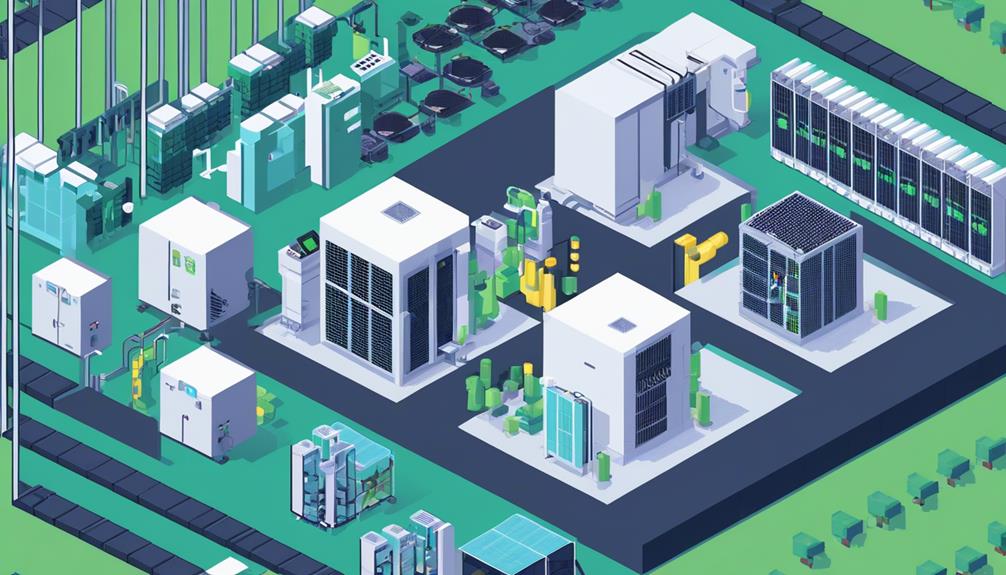
Energy-efficient cooling infrastructure is a critical component of data centers, ensuring optimal performance and minimizing energy consumption. By implementing energy-efficient cooling solutions, data centers can reduce energy costs and contribute to a more sustainable environment. Several strategies can be employed to achieve this goal.
One effective approach is to use variable-speed fans to decrease power consumption. These fans adjust their speed based on the cooling requirements, resulting in significant energy savings. Another option is to consider liquid cooling, which can reduce the energy required for cooling by efficiently transferring heat away from the IT equipment. This technology is particularly effective for high-density data centers.
Optimizing temperature settings is also crucial in reducing power usage. By carefully monitoring and adjusting the temperature, data centers can maintain the optimal operating conditions while minimizing energy consumption. Additionally, utilizing bigger, slower drives and solid-state drives (SSDs) for storage can improve storage efficiency and reduce energy consumption.
Externalizing power consumption by moving IT workloads to the cloud is another strategy to consider. Cloud service providers often have more energy-efficient cooling infrastructure and can leverage economies of scale to reduce energy costs.
To summarize the strategies discussed above, the following table provides a quick overview of the energy-efficient cooling infrastructure options for data centers:
| Strategy | Benefits |
|---|---|
| Variable-speed fans | Decreased power consumption |
| Liquid cooling | Reduced energy required for cooling |
| Optimized temperature settings | Lower power usage |
| Bigger, slower drives and SSDs | Improved storage efficiency |
| Externalizing power consumption | Reduced energy costs through cloud migration |
Efficient Server Utilization
Efficient server utilization is a fundamental aspect of optimizing energy consumption and maximizing performance in data centers. By consolidating lightly-used servers, energy waste can be minimized and server usage can be optimized.
There are several key strategies that can be implemented to achieve efficient server utilization in data centers:
- Implementing efficient data storage measures: By utilizing techniques such as data deduplication and compression, data can be stored more efficiently, reducing the need for additional servers and improving server utilization.
- Utilizing built-in server power management features: Modern servers often come equipped with power management features that allow for dynamic power scaling based on workload. By optimizing these features, servers can operate at the most energy-efficient level while still meeting performance requirements.
- Upgrading to energy-efficient IT equipment: Investing in energy-efficient servers and other IT equipment can significantly improve server utilization and decrease energy consumption. These energy-efficient devices are designed to operate at higher levels of performance while consuming less power.
- Optimizing virtualization technology: Virtualization allows multiple virtual servers to run on a single physical server, increasing server utilization. By optimizing virtualization technology, data centers can achieve higher levels of efficiency and reduce the number of physical servers needed.
- Optimizing power load balancing: Balancing the power load across servers can help ensure that each server is operating at its optimal performance level while minimizing energy waste.
- Using energy-efficient power cables and connectors: Energy-efficient power cables and connectors can minimize power loss and improve server performance, contributing to efficient server utilization.
- Monitoring and managing server performance: Regularly monitoring and managing server performance is crucial for ensuring efficient server utilization. By identifying and addressing performance bottlenecks, data centers can optimize energy consumption and maximize server performance.
Data Center Infrastructure Management
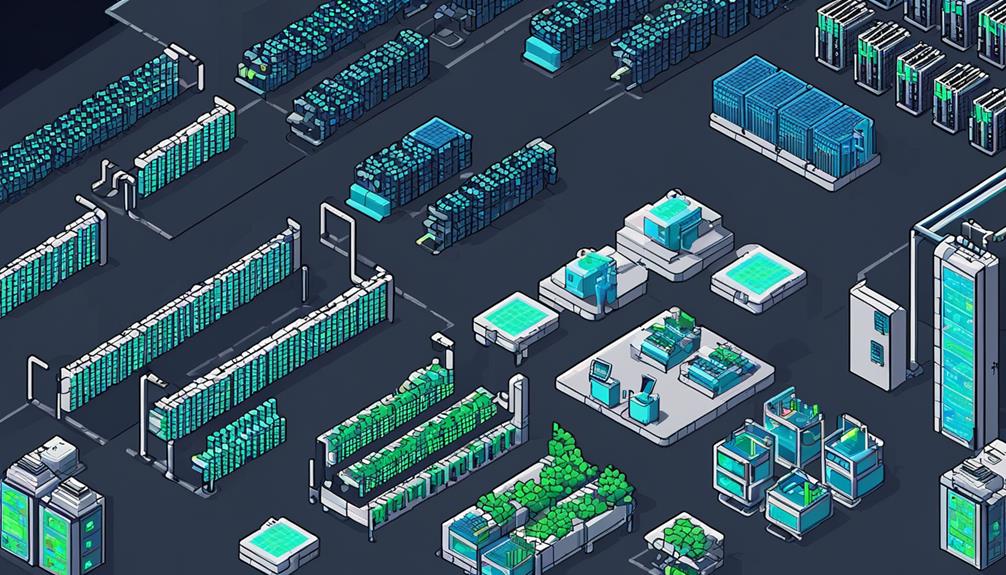
Data Center Infrastructure Management (DCIM) is a comprehensive approach that integrates IT and facility management to optimize energy usage and enhance the performance of a data center's physical infrastructure. DCIM solutions play a crucial role in improving energy efficiency and reducing operational costs in data centers.
One of the key areas where DCIM focuses on is the power supply. DCIM systems provide real-time monitoring and analysis of power usage, enabling data center operators to identify areas of inefficiency and implement measures to optimize energy consumption. By monitoring power usage at the rack level, operators can identify underutilized servers or equipment and consolidate workloads to improve efficiency. This helps in reducing energy wastage and maximizing the utilization of the available power supply.
Furthermore, DCIM systems also monitor thermal conditions within the data center. By collecting data on temperature and humidity levels, operators can identify hotspots and inefficient cooling systems. This information allows for proactive decision-making to optimize cooling and ventilation, ensuring that energy is not wasted in unnecessary cooling efforts.
Asset management is another important aspect of DCIM. It enables data center operators to have comprehensive visibility and control over their infrastructure, including servers, networking equipment, and power distribution units. By having accurate information about the location and status of assets, operators can optimize their utilization, reduce downtime, and improve energy efficiency.
Implementing DCIM empowers data center operators to make informed decisions to improve energy efficiency, reduce carbon footprint, and enhance the sustainability of their operations. By integrating IT and facility management, DCIM systems provide a holistic approach to optimize energy usage and enhance the performance of data center infrastructure.
Green Building Standards
Green building standards are a comprehensive set of criteria and guidelines aimed at promoting the design, construction, and operation of environmentally sustainable buildings. These standards emphasize resource efficiency, energy conservation, waste reduction, and the use of environmentally friendly materials and technologies. Adhering to green building standards can lead to reduced environmental impact, lower operating costs, improved occupant health and productivity, and enhanced overall sustainability. Green building standards encompass various aspects such as building design, materials selection, energy systems, water conservation, indoor environmental quality, and sustainable site development.
To achieve energy efficiency in data centers, green building standards play a crucial role. Here are three ways in which these standards contribute to energy-efficient data centers:
- Building Design: Green building standards encourage the use of design strategies that optimize energy performance. This includes efficient building envelope design, such as insulation and proper sealing, to minimize heat transfer and reduce the load on cooling systems. Additionally, the standards promote the use of natural lighting and ventilation to minimize the need for artificial lighting and mechanical ventilation.
- Energy Systems: Green building standards focus on the utilization of energy-efficient systems in data centers. This includes the installation of high-efficiency HVAC (Heating, Ventilation, and Air Conditioning) systems, efficient lighting fixtures, and advanced power distribution systems. Furthermore, these standards promote the use of renewable energy sources, such as solar panels or wind turbines, to power data centers.
- Monitoring and Control: Green building standards emphasize the implementation of effective monitoring and control systems to optimize energy usage in data centers. This includes the use of automated systems to regulate temperature, humidity, and lighting based on real-time data. By monitoring and adjusting energy consumption, data centers can achieve significant energy savings without compromising performance or reliability.
Best Practices for Energy Efficiency
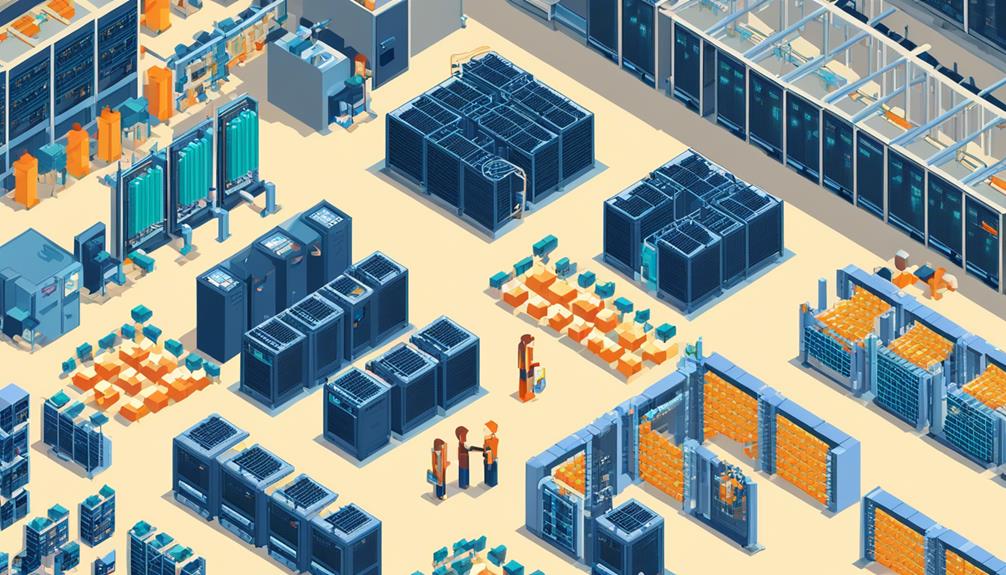
To optimize energy usage and reduce environmental impact, implementing best practices is essential in achieving energy efficiency in data centers. By following these best practices, data center operators can improve energy efficiency, reduce operating costs, and minimize their carbon footprint. Here are some recommended best practices for energy efficiency in data centers:
| Best Practices for Energy Efficiency |
|---|
| Consolidate lightly-used servers and upgrade to energy-efficient IT equipment |
| Implement power monitoring and management systems |
| Optimize power load balancing and reduce energy losses from power distribution units (PDUs) and uninterruptible power supply (UPS) systems |
| Manage airflow for cooling efficiency |
| Adopt a hot aisle/cold aisle layout |
| Utilize containment/enclosures in air flow management |
| Consider a water-side economizer |
| Install in-rack or in-row cooling systems |
| Use an air-side economizer for HVAC optimization |
| Benchmark data center's energy efficiency |
| Select a sustainable colocation facility |
| Provide energy-efficiency awareness training |
Consolidating lightly-used servers and upgrading to energy-efficient IT equipment helps eliminate energy waste and improve overall energy usage. Implementing power monitoring and management systems allows for better control and optimization of power consumption. Optimizing power load balancing and reducing energy losses from PDUs and UPS systems helps minimize energy waste in the power infrastructure.
Managing airflow for cooling efficiency is crucial in data centers. Adopting a hot aisle/cold aisle layout ensures that hot and cold air streams do not mix, improving cooling effectiveness. Utilizing containment/enclosures in air flow management helps direct airflow to where it is needed, reducing cooling energy requirements.
Considering a water-side economizer and installing in-rack or in-row cooling systems can significantly improve cooling efficiency. Additionally, using an air-side economizer for HVAC optimization maximizes the use of outside air for cooling, reducing reliance on mechanical cooling systems.
Benchmarking the data center's energy efficiency helps identify areas for improvement and track progress over time. Selecting a sustainable colocation facility that prioritizes energy efficiency and renewable energy sources can further enhance the data center's overall energy efficiency. Providing energy-efficiency awareness training to staff ensures that everyone understands and follows energy-saving practices.
Frequently Asked Questions
What Is Energy Efficiency in Data Center?
Energy efficiency in data centers refers to the optimization of power consumption and waste reduction in IT equipment. This involves utilizing renewable energy sources, implementing efficient cooling techniques, and leveraging virtualization benefits.
Energy efficiency measures can include consolidating servers, upgrading to energy-efficient equipment, and implementing power monitoring systems. Proper airflow management, HVAC optimization, and energy-efficient lighting systems are also crucial.
Benchmarking energy efficiency and selecting sustainable colocation facilities further contribute to achieving energy-efficient data centers.
What Is Power Usage Efficiency in Data Center?
Power usage efficiency (PUE) in a data center refers to the ratio between the total power consumed by the facility and the power used by IT equipment. It is a key metric used to assess the energy efficiency of data centers.
A lower PUE value indicates higher power efficiency, achieved by minimizing energy consumption for cooling, lighting, and other non-IT equipment.
What Are the 4 Best Practices of a Data Center in Terms of Energy Saving?
In terms of energy saving, data centers can adopt various best practices. These include optimizing data center cooling techniques, such as airflow management and the use of in-rack or in-row cooling systems.
Additionally, data centers can consider leveraging renewable energy sources to power their operations and implementing server virtualization to consolidate server resources and minimize energy consumption.
These practices contribute to increased energy efficiency and sustainability in data centers.
How Can You Make a Data Center More Efficient?
To make a data center more efficient, several strategies can be employed.
Firstly, optimizing data center cooling is crucial. This can be achieved through the implementation of airflow management techniques, such as containment and raised floor tiles.
Secondly, server virtualization can be utilized to consolidate multiple physical servers into virtual machines, reducing the overall energy consumption.
Lastly, integrating renewable energy sources, such as solar or wind power, can significantly reduce the carbon footprint of the data center.
These measures collectively contribute to improved energy efficiency in data centers.

